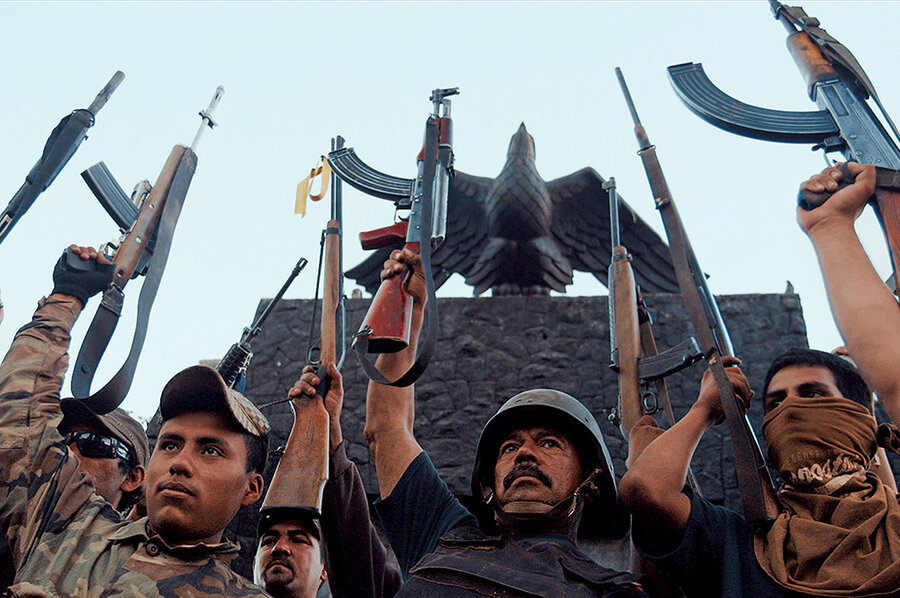'Cartel Land' is eye-opening and shows the shades of gray
Loading...
The eye-opening documentary “Cartel Land” opens with a nighttime scene that would not have looked out of place in “Breaking Bad.” A group of men, their faces masked by bandannas, are cooking meth in a makeshift outdoor lab in the Mexican desert near the border with the United States.
One of the men tells the film’s director, Matthew Heineman: “We know we do harm. If we start paying attention to our hearts, we’ll get screwed over. As long as God allows it, we’ll make drugs.”
This sequence is somewhat anomalous, since for most of the movie Heineman and his equally risk-courting co-cinematographer, Matt Porwoll, embedded themselves inside two vigilante groups aimed at eradicating Mexican drug cartels. They dodged a lot of bullets.
On the American side, in Arizona’s 52-mile desert corridor known as Cocaine Alley, we follow an American veteran, Tim “Nailer” Foley, and his fellow paramilitary volunteers. They call themselves the Arizona Border Recon, and their mission is capturing people who are in the country illegally and turning them over to the federal authorities.
The other group, to which Heineman devotes considerably more time, is the Autodefensas, a cadre of citizen volunteers in the Mexican state of Michoacán, led by the charismatic small-town physician Dr. Jose Mireles, known as “El Doctor.”
These two vigilante outfits came about because of what some saw as a pronounced failure by governments on both sides to protect their respective citizens. The US border patrol in Cocaine Alley, for example, is so undermanned that the area has essentially become a lawless territory. In the Mexican state, government agents are not only ineffectual in policing the cartels but are, in some cases, in cahoots with them.
Under these circumstances, it’s easy to side with the vigilantes. And yet, as the film demonstrates, this is far from a black-and-white situation. Foley, a grizzled, hard-bitten type who could have been cast in an old Chuck Norris movie, talks about the border struggle “to save the country” in terms more befitting a race war. He likens the two peoples, Mexicans and Americans, to pit bulls. Thrown together, how can they not fight?
Heineman shows us at least one instance in which the Arizona vigilantes turn over their captured quarry to the Feds, but I wonder, especially given that the Southern Poverty Law Center deems them an extremist group, whether we are seeing everything there is to see.
The Autodefensas saga is more complex. Having retaken at least six towns from the murderous cartels, Mireles and his men are at first cheered as saviors. But a current of mistrust builds among some of the “liberated” townsfolk, who never asked for gun-wielding vigilantes and are deeply suspicious of their motives. Things begin to unravel when Mireles is seriously injured in a mysterious plane crash and his cohort, a chubby, voluminously bearded man nicknamed “Papa Smurf,” takes over.
Some of the villagers complain to him about corruption within the Autodefensas, and it doesn’t take much imagination to see where this is going. Although Mireles regains his health, his stature in the organization has been compromised. He says to his men, to no avail: “We can’t become the criminals we are fighting against.”
Heineman, despite the risks he took, is inescapably hampered by his limited access to these paramilitary outfits. His switching back and forth between them implies an equivalency that doesn’t really pertain; he might have been better off if he had focused exclusively on the Autodefensas narrative. With his larger-than-life swagger, the mustachioed Mireles is the film’s star, and when this crusader is brought low, his downfall acquires a kind of Shakespearean inevitability. Given what this film is about and the dangers hindering its fullest accounting, a dramatic rendition, rather than a documentary, might have been more emotionally satisfying. Still, there’s nothing like seeing some of this stuff up close and for real. Grade: B+ (Rated R for violent disturbing images, language, drug content, and brief sexual material.)







